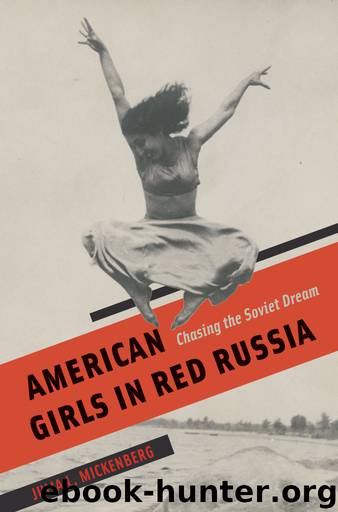American Girls in Red Russia by Julia L. Mickenberg

Author:Julia L. Mickenberg [Mickenberg, Julia L.]
Language: eng
Format: epub
ISBN: 978-0-226-25626-9
Publisher: University of Chicago Press
Published: 2017-04-04T04:00:00+00:00
She was invited to dinner at the home of Andrei Goncharov, a portraitist. Pudovkin was at the dinner, but so was his wife, Anna Nikolaevna Zemtsova, a prominent film critic and actress. Koner found her attractive and intelligent, but did not feel threatened. “Instead I was exceptionally gay, happy and confident in the matter of comparison.” Pudovkin hardly spoke all evening. “I compared youth against age—sparkle against dullness, litheness against bluntness, life against lethargy,” Koner noted in her diary.77
On June 26, in Sverlovsk, Koner turned twenty-three. “Years are adding up and yet for twenty three I have already seen and done a great deal,” she told herself. Koner’s youthful exuberance both heightened her hopes and may have softened the blow when she determined her Moscow dance school was not to be. While still waiting for word about it, Koner received an invitation to teach dance at the Lesgaft Physical Culture Institute in Leningrad, whose program had the closest thing to modern dance in Russia.78
“Physical culture” (fizkul’tura) in the Soviet Union was one of the only arenas for movements that in the United States might be classed as modern dance, especially as nearly all private dance studios (Duncan’s was one of the few exceptions) were closed in April 1924 as part of an effort to centralize instruction. Physical culture emphasized the cultural dimensions of movement, especially gymnastics, which “taught not only discipline and control but also synchronization through group exercises believed to be capable of integrating and uniting individuals.”79
Koner was torn for weeks about whether to take the position at Lesgaft, because it meant giving up or at least delaying plans for opening her own school; it also meant being apart from Pudovkin. One night she called Pudovkin for advice and he, feeling unwell, asked her to come to his house. She wound up spending the evening with Pudovkin and his wife, telling them about her troubles, ultimately finding herself laughing hysterically at the whole situation. “Anna Nikolaevna felt so sorry for me and didn’t know the half of it,” she remarked to her diary.80 She decided to accept the appointment in Leningrad because it would allow her to develop as a dancer and a teacher. In fact, Koner’s real development as a choreographer in the Soviet Union began only once she became involved with the Lesgaft Institute. What Koner didn’t realize was that the appointment put her squarely within the Stalinist project of militarizing Soviet youth.81
Download
This site does not store any files on its server. We only index and link to content provided by other sites. Please contact the content providers to delete copyright contents if any and email us, we'll remove relevant links or contents immediately.
Fanny Burney by Claire Harman(25789)
Empire of the Sikhs by Patwant Singh(22176)
Out of India by Michael Foss(16313)
Leonardo da Vinci by Walter Isaacson(11913)
Small Great Things by Jodi Picoult(6103)
The Six Wives Of Henry VIII (WOMEN IN HISTORY) by Fraser Antonia(4797)
The Wind in My Hair by Masih Alinejad(4427)
The Lonely City by Olivia Laing(4122)
The Crown by Robert Lacey(4111)
A Higher Loyalty: Truth, Lies, and Leadership by James Comey(4038)
The Iron Duke by The Iron Duke(3642)
Millionaire: The Philanderer, Gambler, and Duelist Who Invented Modern Finance by Janet Gleeson(3574)
Sticky Fingers by Joe Hagan(3456)
Alive: The Story of the Andes Survivors by Piers Paul Read(3317)
Papillon (English) by Henri Charrière(3276)
Joan of Arc by Mary Gordon(3263)
Stalin by Stephen Kotkin(3089)
Aleister Crowley: The Biography by Tobias Churton(3024)
Ants Among Elephants by Sujatha Gidla(2927)
